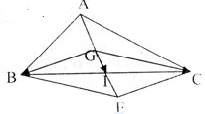Hãy nhập câu hỏi của bạn vào đây, nếu là tài khoản VIP, bạn sẽ được ưu tiên trả lời.

a: \(\overrightarrow{AE}=\dfrac{2}{3}\overrightarrow{EC}\)
=>E nằm giữa A và C và AE=2/3EC
Ta có: AE+EC=AC(E nằm giữa A và C)
=>\(AC=\dfrac{2}{3}EC+EC=\dfrac{5}{3}EC\)
=>\(\dfrac{AE}{AC}=\dfrac{\dfrac{2}{3}EC}{\dfrac{5}{3}EC}=\dfrac{2}{3}:\dfrac{5}{3}=\dfrac{2}{5}\)
=>\(AE=\dfrac{2}{5}AC\)
=>\(\overrightarrow{AE}=\dfrac{2}{5}\cdot\overrightarrow{AC}\)
\(\overrightarrow{BE}=\overrightarrow{BA}+\overrightarrow{AE}\)
\(=-\overrightarrow{AB}+\dfrac{2}{5}\cdot\overrightarrow{AC}\)
b: \(\left|\overrightarrow{IA}+\overrightarrow{IG}\right|=\left|\overrightarrow{IA}-\overrightarrow{IG}\right|\)
=>\(\left[{}\begin{matrix}\overrightarrow{IA}+\overrightarrow{IG}=\overrightarrow{IA}-\overrightarrow{IG}\\\overrightarrow{IA}+\overrightarrow{IG}=\overrightarrow{IG}-\overrightarrow{IA}\end{matrix}\right.\)
=>\(\left[{}\begin{matrix}2\cdot\overrightarrow{IG}=\overrightarrow{0}\\2\cdot\overrightarrow{IA}=\overrightarrow{0}\end{matrix}\right.\Leftrightarrow\left[{}\begin{matrix}I\equiv G\\I\equiv A\end{matrix}\right.\)

mk bận đi ch nên chỉ tạm câu a nha
vẽ 3 đường trung tuyến AD ; BE ; CF
VT =
\(GA+GB+GC\) ( nhớ thêm dấu vec tơ nha )
\(=-\frac{2}{3}AD-\frac{2}{3}BE-\frac{2}{3}CF\)
\(=-\frac{2}{3}\cdot\frac{1}{2}\left(AB+BC\right)-\frac{2}{3}\cdot\frac{1}{2}\left(BA+BC\right)-\frac{2}{3}\cdot\frac{1}{2}\left(CA+CB\right)\) ( quy tắc hình bình hành )
\(=-\frac{1}{3}\left(AB+AC\right)-\frac{1}{3}\left(BA+BC\right)-\frac{1}{3}\left(CA+CB\right)\)
\(=-\frac{1}{3}AB-\frac{1}{3}AC-\frac{1}{3}BA-\frac{1}{3}BC-\frac{1}{3}CA-\frac{1}{3}CB\)
\(=0=VP\)

* cái này là công thức rồi bn o cần chứng minh đâu
công thức : cho tam giác ABC ; nếu G là trọng tâm của tam giác ABC thì \(\overrightarrow{GA}+\overrightarrow{GB}+\overrightarrow{GC}=\overrightarrow{0}\)
Gọi M trung điểm BC
G đối xứng D qua M
=> tứ giác BGCD là hình bình hành
=> GD=2.GM (Hình bình hành có 2 đường chéo cắt nhau tại trung điểm của mỗi đường)
Mà AG = 2.GM ( \(\dfrac{AG}{GM}=\dfrac{2}{1},GA=\dfrac{2}{3}AM\) )
⇒ AG=GD
Mặt khác, G ϵ AD
⇒\(\overrightarrow{AG}=\overrightarrow{GD}\)
Ta có \(\overrightarrow{GB}+\overrightarrow{GC}=\overrightarrow{GD}\) (Quy tắc hình bình hành)
Nên \(\overrightarrow{GB}+\overrightarrow{GC}+\overrightarrow{GA}\) = \(\overrightarrow{GD}+\overrightarrow{GA}\)
Mà \(\overrightarrow{AG}=\overrightarrow{GD}\) (cmt)
⇒\(\overrightarrow{AG}+\overrightarrow{GA}=\overrightarrow{AG}-\overrightarrow{AG}=\overrightarrow{O}\)

Lời giải:
Kéo dài $MG$ cắt $AC$ tại $T$ thì $T$ là trung điểm $AC$
\(\Rightarrow \overrightarrow{TA}+\overrightarrow{TC}=\overrightarrow{0}\)
Theo giả thiết của điểm M suy ra M nằm trên đoạn $AB$ sao cho \(MA=\frac{1}{2}MB\)
Theo tính chất đường trung tuyến suy ra
\(3\overrightarrow{GM}=2\overrightarrow{TM}=(\overrightarrow{TA}+\overrightarrow{AM})+(\overrightarrow{TC}+\overrightarrow{CM})\)
\(=(\overrightarrow{TA}+\overrightarrow{TC})+\overrightarrow{AM}+\overrightarrow{CM}\)
\(=\overrightarrow{AM}+\overrightarrow{CM}=\overrightarrow{AG}+\overrightarrow{GM}+\overrightarrow{CG}+\overrightarrow{GM}\)
\(\Leftrightarrow \overrightarrow{GM}=\overrightarrow{AG}+\overrightarrow{CG}=-(\overrightarrow{GA}+\overrightarrow{GC})\)
\(\Leftrightarrow \overrightarrow{GM}+\overrightarrow{GA}+\overrightarrow{GC}=\overrightarrow{0}\)
\(\Leftrightarrow \overrightarrow{GB}+\overrightarrow{BM}+\overrightarrow{GA}+\overrightarrow{GC}=\overrightarrow{0}\)
\(\Leftrightarrow \overrightarrow{GB}+\frac{2}{3}\overrightarrow{BA}+\overrightarrow{GA}+\overrightarrow{GC}=\overrightarrow{0}\)
\(\Leftrightarrow \overrightarrow{GB}+\frac{2}{3}(\overrightarrow{BG}+\overrightarrow{GA})+\overrightarrow{GC}=\overrightarrow{0}\)
\(\Leftrightarrow \frac{1}{3}\overrightarrow{GB}+\frac{5}{3}\overrightarrow{GA}+\overrightarrow{GC}=\overrightarrow{0}\)
\(\Leftrightarrow 5\overrightarrow{GA}+\overrightarrow{GB}+3\overrightarrow{GC}=\overrightarrow{0}\)
b)
\(\overrightarrow{IA}=k\overrightarrow{IB}\Leftrightarrow \overrightarrow{IA}-\overrightarrow{IB}=(k-1)\overrightarrow{IB}\)
\(\Leftrightarrow \overrightarrow{BA}=(k-1)\overrightarrow{IB}\)
Do đó : \(\overrightarrow {GI}=\overrightarrow{GB}+\overrightarrow{BI}=\overrightarrow{GB}-\overrightarrow{IB}\) \(=\overrightarrow{GB}-\frac{\overrightarrow{BA}}{k-1}\)
\(=\overrightarrow{GB}-\frac{\overrightarrow{BG}+\overrightarrow{GA}}{k-1}\)
\(=\frac{k}{k-1}\overrightarrow{GB}-\frac{1}{k-1}\overrightarrow{GA}\)
b)
Vì \(\overrightarrow{IA}=k\overrightarrow {IB}\Rightarrow I,A,B\) thẳng hàng
Mà $G$ là trọng tâm $ACM$ nên để $C,G,I$ thẳng hàng thì \(I\) là trung điểm của $AM$
Khi đó: \(\overrightarrow{IA}=\frac{1}{2}\overrightarrow{MA}=\frac{1}{6}\overrightarrow{BA}=\frac{1}{6}(\overrightarrow{BI}+\overrightarrow{IA})\)
\(\Leftrightarrow 5\overrightarrow{IA}=\overrightarrow{BI}\Leftrightarrow \overrightarrow{IA}=-\frac{1}{5}\overrightarrow{IB}\)
Vậy \(k=\frac{-1}{5}\)